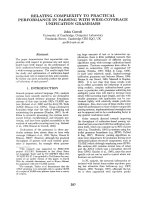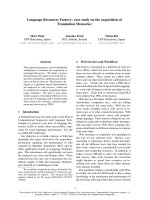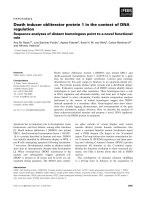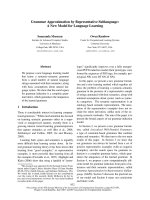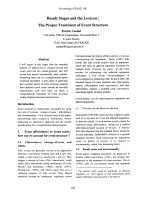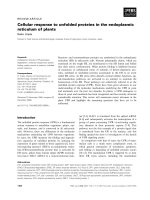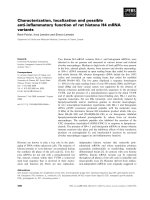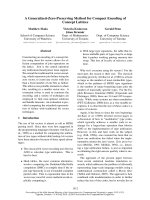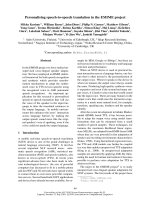Báo cáo khoa học: Alcohol linked to enhanced angiogenesis in rat model of choroidal neovascularization pot
Bạn đang xem bản rút gọn của tài liệu. Xem và tải ngay bản đầy đủ của tài liệu tại đây (777.36 KB, 12 trang )
Alcohol linked to enhanced angiogenesis in rat model
of choroidal neovascularization
Puran S. Bora*, Sankaranarayanan Kaliappan*, Qin Xu*, Shalesh Kumar*, Yali Wang*,
Henry J. Kaplan and Nalini S. Bora*
Department of Ophthalmology and Visual Science, Kentucky Lions Eye Center, University of Louisville, KY, USA
Age-related macular degeneration (AMD) is the leading
cause of blindness in the Western world in people aged
over 55. Exudative (i.e. wet-type) AMD is characterized
by the development of new vessels within the choroid of
the eye (i.e. choroidal neovascularization; CNV) [1].
This neovasculature penetrates Bruch’s membrane and
grows beneath the retinal pigment epithelium and neu-
rosensory retina [2–7]. Many different growth factors
have been implicated in the development of choroidal
angiogenesis [8–18]; including vascular endothelial
growth factor (VEGF) [9,19,20]. More recently, an
important role for various cell populations and cellular
proteins – macrophages, hematopoietic stem cells and
complement proteins [21–23] has been identified.
Several studies have shown that the nonoxidative
ethanol metabolites, fatty acid ethyl esters (FAEE),
are synthesized by the esterification of free fatty acids.
The reaction is catalyzed by FAEE synthase (FAEES)
Keywords
adiponectin; angiogenesis; choroids; macular
degeneration; neovascularization
Correspondence
P. S. Bora, Department of Ophthalmology,
Jones Eye Institute, University of Arkansas
for Medical Sciences, 4301 West Markham,
# 523 Little Rock, AR 72205, USA
Fax: +1 501 686 7037
Tel: +1 501 686 5150
E-mail:
*Present address
Jones Eye Institute, University of Arkansas
for Medical Sciences, Little Rock, AR, USA
(Received 17 January 2006, accepted 2
February 2006)
doi:10.1111/j.1742-4658.2006.05163.x
One of the pathologic complications of exudative (i.e. wet-type) age-related
macular degeneration (AMD) is choroidal neovascularization (CNV). The
aim of this study was to investigate whether chronic and heavy alcohol
consumption influenced the development of CNV in a rat model. The oxi-
dative metabolism of alcohol is minimal or absent in the eye, so that eth-
anol is metabolized via a nonoxidative pathway to form fatty acid ethyl
esters (FAEE). Fatty acid ethyl ester synthase (FAEES) was purified from
the choroid of Brown Norway (BN) rats. The purified protein was 60 kDa
in size and the antibody raised against this protein showed a single band
on western blot. BN rats on a regular diet were fed alcohol for 10 weeks.
Control rats were fed water with a regular diet and pair-fed control rats
were fed regular diet, water and glucose. We found that FAEES activity
was increased 4.0-fold in the choroid of alcohol-treated rats compared with
controls. The amount of ethyl esters produced in the choroid of 10 week
alcohol-fed rats was 7.4-fold more than rats fed alcohol for 1 week. The
increased accumulation of ethyl esters was associated with a 3.0-fold
increased expression of cyclin E and cyclin E ⁄ CDK2; however, the level of
the cyclin kinase inhibitor, p27Kip, did not change. The increased accumu-
lation of ethyl esters was also associated with 3.0-fold decreased expression
of APN in the choroid. We also found that the size of CNV increased by
28% in alcohol-fed rats. Thus, our study showed that chronic, heavy alco-
hol intake was associated with both an increased accumulation of ethyl
esters in the choroid and an exacerbation of the CNV induced by laser
treatment. These results may provide insight into the link between heavy
alcohol consumption and exudative AMD.
Abbreviations
AMD, age-related macular degeneration; APN, adiponectin; BN rat, brown Norway rat; CDK2, cyclin E-dependent kinase 2; CNV, choroidal
neovascularization; FAEE, fatty acid ethyl ester; FAEES, fatty acid ethyl ester synthase; PEDF, pigment epithelium-derived factor; RPE,
retinal pigment epithelium; VEGF, vascular endothelial growth factor.
FEBS Journal 273 (2006) 1403–1414 ª 2006 The Authors Journal compilation ª 2006 FEBS 1403
[24–32]. In addition to heart, brain, liver and pancreas,
nonoxidative alcohol metabolism also exists in the eye
[24,25]. The nonoxidative ethanol metabolism pathway
and its metabolites such as FAEE may play an import-
ant role in the development and ⁄ or enhancement of
CNV. Cell proliferation is governed by regulatory cell-
cycle proteins, such as cyclin E and cyclin E ⁄ CDK2,
Li et al. [33], showed that hepatic stellate cells treated
with FAEE (linoelic acid ethyl ester) have increased cy-
clin E expression and cyclin E ⁄ CDK2 activity, suggest-
ing that FAEE may have promitogenic effects [34].
Adiponectin (APN) is an antiangiogenesis protein and
circulating concentrations of APN decreased signifi-
cantly following chronic consumption of alcohol [35,36].
The balance between angiogenic factors and inhibitors
is important for the angiogenesis process and has not
previously been studied in the choroid of alcoholic rats.
Although there have been numerous studies using
laser-induced CNV as a model of choroidal angiogene-
sis [2–7,21–23], none has studied the effect of chronic
and heavy alcohol consumption on the neovasculature.
We investigated the effect of chronic and heavy alco-
hol feeding on alcohol metabolism in the choroid and
on the development of CNV in a rat model. We used
ethyl alcohol (100% proof mixed with water) to feed
the rats. Because it is easy to feed alcohol to rats and
they are a good source of choroidal tissue from which
to purify FAEES enzyme, we used a rat model to
induce CNV in this study.
Results
Purification of FAEES
FAEES was purified to homogeneity from rat choroid
using a previously described method [29]. The enzyme
was purified 9000-fold to homogeneity on a hydroxylap-
atite column with 30% yield; SDS ⁄ PAGE showed a
single band of molecular mass 60 kDa (Fig. 1A). The
N-terminal sequence of the purified protein matched
100% with rat adipose tissue FAEES protein (data not
shown) [29]. Purified FAEES was transferred to a nitro-
cellulose membrane and the purified protein reacted
with an antibody raised in the rabbit against FAEES; a
single 60 kDa band was observed on the western blot
(Fig. 1B). These results suggested that FAEES, a
60 kDa protein, is present in the choroid of the rat eye.
FAEES activity
The cornea, iris and ciliary body, lens, retina and chor-
oid were collected separately from the eyes of control
rats and rats fed alcohol for 10 weeks to assay synthase
activity. No significant increase in FAEES activity was
observed in the cornea, iris and ciliary body, lens and
retina of either group. However, a 4.0-fold increase in
FAEES activity was observed in the choroid of alcohol-
fed rats compared with regular controls (Fig. 2A). Cho-
roidal FAEES activity in regular and pair-fed controls
was the same (data not shown). The kinetic constants of
the enzyme purified from the choroid had similar K
m
values compared with the heart enzyme for both oleic
acid and ethanol; however, the V
max
values were four-
fold lower for both substrates compared with the heart
enzyme (Table 1). The calculated K
m
and V
max
values of
the choroidal enzyme for oleic acid were 0.24 mm and
1020 nmolÆmg
)1
Æh
)1
, respectively, and the calculated K
m
and V
max
for ethanol were 0.41 m and 930 nmolÆ
mg
)1
Æh
)1
, respectively (Table 1).
Immunohistochemistry studies
Paraffin sections of the posterior segment of eyes were
immunostained for FAEES using anti-FAEES serum
(raised in rabbits). The eyes of rats fed alcohol for
10 weeks showed increased staining for FAEES com-
pared with control rats (Fig. 2B).
FAEE production
The induction of FAEES activity produced 7.2- and
7.4-fold more ethyl esters in the choroid of rats fed
60 kDa
AB
60 kDa
94
kDa –
67 kDa –
43 kDa –
29
kDa –
20
kDa –
14
kDa –
12
12
Fig. 1. (A) SDS ⁄ PAGE analysis of purified FAEES from rat choroid.
Purification was performed as described in the Experimental proce-
dures. Lane 1, molecular mass markers; lane 2, purified FAEES,
60 kDa. (B) Western blot analysis of purified FAEES. Antibody
(raised in rabbit) against FAEES was used to react with pure FAEES
protein. Lane 1 shows no band (control lane). Rat albumin was
used as control protein. Lane 2 shows a clear band at 60 kDa.
Alcohol and choroidal neovascularization P. S. Bora et al.
1404 FEBS Journal 273 (2006) 1403–1414 ª 2006 The Authors Journal compilation ª 2006 FEBS
alcohol for 9 and 10 weeks, respectively, compared
with rats fed alcohol for 1 week (Table 2). Ethyl esters
production increased as the number of weeks of
alcohol feeding increased (Table 2). However, no
control
alcohol fed
cornea
A
B
FAEES ACTIVITY (nmol/mg protein/hr)
10
8
6
4
2
0
iris&cb lens retina
Choroid
ba
Fig. 2. (A) fatty acid ethyl ester synthase (FAEES) activity was assayed using the method described previously [28–31]. Cornea, iris and cili-
ary body, lens, retina and choroid were separated from the eyes of control rats (no alcohol) and rats fed alcohol for 10 weeks to assay syn-
thase activity. No significant increase in FAEES activity was seen in the cornea, iris and ciliary body, lens and retina. However, a 4.0-fold
increase in FAEES activity was observed in the choroid of alcohol-fed rats compared with controls. (B) Immunohistological analysis of FAEES
in the posterior region of the rat eye. Immunohistology was performed using FAEES antibody and immunoperoxidase staining kit. (A) Control
rats showed mild staining (brown color in the choroid). (B) Rats fed alcohol for 10 weeks showed several fold increase in staining (brown
staining is marked by black arrows in the choroid) compared with controls. Cell layers are marked as shown here: SC, sclera; CH, choroids;
RPE, retinal pigment epithelium; OLM, outer limiting membrane; ONL, outer nuclear layer; OSL, outer synaptic layer; INL, inner nuclear
layer; ISL, inner synaptic layer.
Table 1. Kinetic constants of FAEES, purified from rat choroid.
Oleic acid and ethanol were used as substrates for FAEES activity.
Enzyme Substrate K
m
V
max
(nmolÆmg
protein
)1
Æh
)1
)
FAEES Oleic acid 0.24 ± 0.07 m
M 1020 ± 5.24
(Choroid) Ethanol 0.41 ± 0.05
M 930 ± 4.35
FAEES Oleic acid 0.20 ± 0.02 m
M 3950 ± 9.85
(Heart)
a
Ethanol 0.30 ± 0.04 M 3700 ± 8.22
a
See Bora et al. [29].
Table 2. Ethyl esters produced in the choroid of alcohol-fed rats. A
7.2- and 7.4-fold increase in the production of ethyl esters was
observed in 9- and 10-week alcohol-fed rats, respectively, com-
pared with 1-week alcohol-fed rats in the choroid. However, no dif-
ference in ethyl ester production was observed in 4, 8, 9 and
10 weeks of alcohol feeding compared with 1-week alcohol-fed
(control) rats in the cornea, iris and ciliary body, lens and retina.
Weeks of
alcohol feeding
Ethyl ester formation
(nmolÆg
)1
wet weight)
1 2.30 ± 0.80
4 6.50 ± 0.92
8 10.10 ± 0.75
9 16.60 ± 1.10
10 17.10 ± 1.22
P. S. Bora et al. Alcohol and choroidal neovascularization
FEBS Journal 273 (2006) 1403–1414 ª 2006 The Authors Journal compilation ª 2006 FEBS 1405
significant changes were seen in ethyl esters production
in the cornea, iris and ciliary body, lens and retina of
9- and 10-week alcohol-fed rats (Table 2).
Size of the CNV complex
Ten days after laser treatment (on day 70) alcohol-fed,
regular and pair-fed control rats were killed to evaluate
the effect of alcohol on the size of CNV. There was a
28% increase (P<0.005) in CNV complex size in alco-
hol-fed rats compared with regular and pair-fed controls
(Fig. 3). However, there was no difference in CNV size
between regular and pair-fed controls (Fig. 3). The val-
ues in each group were averaged from 80 laser spots.
Confocal microcopy images of flat mounts (RPE–
choroid–sclera) are shown in Fig. 4Aa–d. There was a
significant increase in the size of the CNV complex in
alcohol-fed rats (Fig. 4Ab) compared with controls
(Fig. 4Aa). Interestingly, we did not observe any signi-
ficant difference in CNV complex size in rats fed alco-
hol for 8 weeks (Fig. 4Ac,d). The CNV size in pair-fed
controls (Fig. 4Ba) was the same as in regular controls
(Fig. 4Bb). However, alcohol-fed rats (Fig. 4Bd) had a
significantly higher CNV size compared with pair-fed
rats (Fig. 4B). These results indicated that chronic
and heavy consumption of alcohol for 10 weeks
increased the size of the CNV in the laser-induced rat
model.
Cyclin E and cyclin E ⁄ CDK2
In order to explore the mechanism of the alcohol-asso-
ciated increase in CNV size we measured the levels of
cyclin E and cyclin E ⁄ CDK2 by western blot in alco-
hol-fed rats. We found a 3.0-fold increase in cyclin E
and cyclin E ⁄ CDK2 levels in rats fed alcohol
for 10 weeks compared with controls (nonalcohol and
1-week alcohol-fed rats) (Fig. 5A). Laser photocoagu-
lation alone had no effect on the expression of these
proteins (Fig. 5A). Interestingly, we saw no change in
cyclin E and cyclin E ⁄ CDK2 expression levels in rats
fed alcohol for 8 weeks (Fig. 5B). These rats also
showed no change in CNV size after laser induction.
Expression of the cyclin kinase inhibitor, p27Kip, was
not changed in any of these groups (Fig. 5A,B).
APN study
Immunohistochemistry showed that APN was
expressed in the choroid of the rat eye. No other tissue
was stained in the rat eye (Fig. 6A). RT-PCR data
showed that expression of APN mRNA in the rat
choroid was significantly decreased in the choroids of
rats fed alcohol for 10 weeks compared with controls
(Fig. 6B, upper). Similarly, western blot showed a sig-
nificantly decreased level of protein amount in the
choroid of alcoholic rats compared with regular con-
trols (Fig. 6B, middle). In an in vitro study when rat
choroidal endothelial cells were treated with 50 lm
ethyl esters, there was significantly decreased expres-
sion of APN mRNA compared with control cells (not
treated with ethyl esters) (Fig. 6B, lower).
Discussion
AMD is the most common cause of permanent visual
impairment among the elderly, and several million new
cases are diagnosed each year around the world
[37,38]. It consists of two major forms, nonexudative
(dry-type) and exudative (wet-type) AMD. Approxi-
mately 10–12% of patients have the wet form, which is
characterized by the presence of CNV and is respon-
sible for 90% of severe central vision loss from AMD
[1,37–39]. There is no treatment that will reliably
recover lost central vision, although there are currently
several clinical trials in phase II ⁄ III testing using anti-
angiogenic pharmaceuticals. Although there is no per-
fect animal model to study CNV that resembles
humans, the laser-induced model may be the best
available animal model to study CNV. CNV can be
induced by laser in mouse, rat, pig, rabbit and mon-
key. In this study we used rats to study CNV because
rats are easy to feed alcohol and it is economical to
get enough choroidal tissue to purify FAEES enzyme.
There are currently 12 million alcoholics in the USA
and over 80 million worldwide [26]. The epidemiologic
18
16
14
12
10
8
4
6
2
0
Control
CNV Size (× 10
3
µm)
Pair-fed Alcohol-fed
Fig. 3. Comparison of CNV complex size (i.e. area) of regular control,
pair-fed control and 10-week alcohol-fed rats. CNV complex size was
measured using
IMAGE PRO-PLUS software in micron unit. There was a
28% increase (P<0.005) in the CNV complex size in alcohol-fed rats
compared with both the controls rats (regular control and pair-fed
control). The values in each group were averaged from 80 laser
spots. The incidence of CNV in each group was 92%.
Alcohol and choroidal neovascularization P. S. Bora et al.
1406 FEBS Journal 273 (2006) 1403–1414 ª 2006 The Authors Journal compilation ª 2006 FEBS
a
B
A
cd
b
a
cd
b
Fig. 4. (A, (a–d)). Confocal microcopy imag-
es of flat mounts (RPE–choroid–sclera) from
rats perfused with fluorescein–dextran
(green color) and stained with elastin (red
color). Elastin stains Bruchs membrane
(red), the CNV complex is green. There was
a significant increase in the size of the CNV
complex in alcohol-fed (10 weeks) rats
(A, b; 2500·), compared with control rats
(A, a; 2500·). However, no significant
increase in the CNV complex size was
observed in rats fed alcohol for 8 weeks
(A, d; 2500·) compared with control rats
(A, c; 2500·). (B, (a–d)) Confocal microcopy
images of flat mounts (RPE–choroid–sclera)
from rats perfused with fluorescein–dextran
(green) and stained with elastin (red). Elastin
stains Bruchs membrane (red), the CNV
complex is green. There was a significant
increase in size of the CNV complex in alco-
hol-fed (10 weeks) rats (b, d; 2500·), com-
pared with pair-fed controls (B, c; 2500·).
However, there was no difference in the
CNV complex size of pair-fed controls
(B, a; 2500·) compared with regular controls
(B, bx; 2500 ·).
P. S. Bora et al. Alcohol and choroidal neovascularization
FEBS Journal 273 (2006) 1403–1414 ª 2006 The Authors Journal compilation ª 2006 FEBS 1407
association between alcohol consumption and AMD is
not clear. The Beaver Dam eye studies and studies by
Azen et al. [40–43] suggested that a heavy alcohol
intake is associated with an increased risk of exudative
AMD [43].
Alcohol is metabolized in the eye mainly via a non-
oxidative pathway using the enzyme FAEES [24,25].
Although ADH4 is present in eye tissue, it does not
metabolize alcohol because of the high K
m
value for
alcohol. Retinol oxidation is the main function of
the enzyme in the eye [44–47]. Purified rat choroidal
FAEES is 60 kDa in size. The K
m
values for two sub-
strates, oleic acid and ethanol, were similar to the
value for the enzyme purified from the human heart;
however, the V
max
values were fourfold lower than
that of human heart FAEES. This may be due to a
species difference [29,44,45].
In this study, we showed that feeding a rat alcohol
(8 gÆkg
)1
) for 10 weeks increased FAEES activity in
the choroid by 4.0-fold. No change in FAEES activity
was noted in the cornea, iris and ciliary body, lens or
retina. Immunohistological staining showed a qualitat-
ive increase in FAEES in the choroid of alcohol-trea-
ted rats compared with controls. The increased
FAEES activity resulted in increased production and
accumulation of ethyl esters in the choroid of alcohol-
fed rats, with the size of the increase related to the
number of weeks of alcohol feeding.
The increased concentration of ethyl esters within
the choroid corresponded to a statistically significant
increase in the size of CNV in alcohol-fed rats
(10 weeks) compared with regular and pair-fed control
rats. There was no difference in the CNV size of regu-
lar controls compared with pair-fed controls. The data
suggest that either one or both of the controls may be
used for the study. We believe that this is the first
report to show an effect of alcohol consumption on
experimental choroidal angiogenesis. We also observed
increased expression of cell-cycle proteins, cyclin E and
cyclin E ⁄ CDK2, in the choroid after 10 weeks of alco-
hol feeding. These proteins are known to play an
important role in the proliferation of cells, including
endothelial cells [33,34,48,49]. The change in expres-
sion of these cell-cycle proteins may be related to the
amount of ethyl ester in the choroid. Previous studies
have shown that ethyl esters have promitogenic activity
and can increase the expression of cyclin E and
cyclin E ⁄ CDK2 [33]. As shown in Table 2, the accu-
mulation of ethyl esters increased with the number of
weeks of alcohol feeding. The amount (17.10 nmolÆg
)1
wet weight) of ethyl ester accumulated after 10 weeks
of alcohol feeding may be enough (just above the
threshold level) to increase the expression of cyclin E
and cyclin E ⁄ CDK2 by 3.0-fold, which may have con-
tributed to the 28% increase in the size of CNV.
Because laser treatment in rats on a normal diet did
not change cyclin E and cyclin E ⁄ CDK2 expression in
the choroid, we believe that chronic and heavy alcohol
Cyclin E
Cyclin E/CDK2
p27 kip
Cyclin E
Cyclin E/CDK2
p27 kip
12
12
34
A
B
Fig. 5. (A, B) Western blots of cyclin E, cyclin E ⁄ CDK2 and p27Kip.
Rat cyclin E and p27Kip antibodies were used to blot these pro-
teins. Immunoprecipitation of cyclin E ⁄ CDK2 was performed using
rat cyclin E antibody. Choroid was removed from the following
groups of rats, homogenized in solublizing buffer and the superna-
tant were used to run the gels. (A) Expression of cyclin E,
cyclin E ⁄ CDK2 was increased threefold in rats fed alcohol for
9 weeks compared with rats fed alcohol for 1 week and rats not
fed alcohol (lane 1, no alcohol control; lane 2, 1 week of alcohol;
lane 3, 9 weeks of alcohol; lane 4, 9 weeks of alcohol and laser
photocoagulated). However, no change was observed in the
expression of p27Kip in these rats. (B) No change in the expression
of cyclin E, cyclin E ⁄ CDK2 and p27Kip was observed in the rats fed
alcohol for 8 weeks compared with those fed alcohol for 1 week
(lane 1, 1 week of alcohol; lane 2, 8 weeks of alcohol). The amount
of protein used to run the gel was (A) cyclin E, lane 1–4, 6.0 lg;
cyclin E ⁄ CDK2, lane 1–4, 6.0 lg; p27Kip, lane 1–4, 10.0 lg. (B)
Cyclin E, lane 1–2, 6.5 lg; cyclin E ⁄ CDK2, lane 1–2, 10.0 lg; p27
Kip, lane 1–2, 8.5 lg.
Alcohol and choroidal neovascularization P. S. Bora et al.
1408 FEBS Journal 273 (2006) 1403–1414 ª 2006 The Authors Journal compilation ª 2006 FEBS
intake was important in the increased expression of
these proteins. Our hypothesis that a certain level of
ethyl esters was needed to increase the size of CNV
complex was further supported by our observation
that cyclin E and cyclin E ⁄ CDK2 expression did not
change in the choroid of alcohol-fed rats after 8 weeks
and we found no significant difference in the size of
the CNV complex after 8 weeks of alcohol consump-
tion.
Cyclin E and cyclin E ⁄ CDKs can be regulated by
growth-promoting signals on cyclin synthesis and on
the assembly of cyclin ⁄ CDK complexes. The
complexes can be further regulated by cyclin kinase
inhibitors [33,48,49]. Although we observed a
3.0-fold increase in the expression of cyclin E and
cyclin E ⁄ CDK2 in the choroid of alcohol-fed rats at
10 weeks, we did not see a change in the expression of
p27Kip, a cyclin kinase inhibitor. Thus, the increased
expression of cyclin E and cyclin E ⁄ CDK2 appeared
to be the result of increased production and not
decreased cyclin kinase inhibition.
Studies have shown that actively growing
healthy or pathological tissues express high levels of
angiogenic factors. It is also known that high levels
of angiogenic factors may not be sufficient to induce
angiogenesis, i.e. VEGF is expressed at high levels in
several quiescent adult tissues that lack active angiogen-
esis. Thus, downregulation of antiangiogenic factors
may help to enhance angiogenesis. In a mouse tumor
model, Brakenhielm et al. [35] showed that APN was a
direct inhibitor of angiogenesis. Xu et al. [36] showed
that circulating APN was decreased in alcoholics. We
have also shown that choroidal APN expression and
protein levels were decreased in 10-week alcoholic rats
compared with controls. Thus, downregulation of APN
may be another factor that helped to enhance the cho-
roidal angiogenesis in 10-week alcoholic rats. We did
not see any affect of alcohol feeding in the expression of
pigment epithelium-derived factor (PEDF, an angiogen-
esis inhibitor) in the laser spots of alcohol-fed rats com-
pared with controls (data not shown). There is no
evidence in the literature to show the affect of alco-
hol in the expression of other endogenous angiogenesis
inhibitors.
Fig. 6. (A) Immunohistological analysis of choroidal APN. Immuno-
histology was performed using adiponectin antibody (primary anti-
body) in paraffin-embedded rat eyes with CY3-labeled goat (anti-
mouse IgG) serum (secondary antibody), mounting with Aqua-
Mount (Lerner Laboratories, PA). Sections were examined under
fluorescence microscope (Zeiss). Only choroids showed staining
(red in the choroid). No other tissue was stained in the eye. APN is
expressed specifically in the choroid. (B) (Upper) Adiponectin (APN)
mRNA expression in alcohol-fed (lane 3) and control (lane 4) BN rat
choroids. Lanes 1 and 2 are GAPDH lanes. The figure shows ethi-
dium bromide-stained bands for PCR product after UV exposure.
Equal amounts of total RNA (0.2 lg) were used to detect the
mRNA levels of GAPDH and APN. APN expression in 10-weeks
alcoholic rat choroid was significantly decreased compared with
control choroid. (Middle) Western blot of rat choroid. APN antibody
was used to blot choroidal proteins. Choroids were removed from
the alcoholic and control rats, homogenized and the supernatant
was used to run the gel to blot with APN antibody. APN protein
was significantly decreased in 10-week alcoholic rats (lane 1) com-
pared with controls (lane 2). The amount of protein loaded in each
lane was 8 lg. (Lower) APN mRNA expression in rat choroidal
endothelial cell. Lane 3, 50 l
M ethyl ester-treated cells; lane 4, con-
trol cells, not treated with ethyl esters. Lanes 1 and 2 are GAPDH
lanes. The figure shows ethidium bromide-stained bands for PCR
product after UV exposure. Equal amounts of the total RNA
(0.2 lg) were used to detect the mRNA levels of GAPDH and APN.
APN expression in 50 l
M ethyl ester-treated cells was significantly
decreased compared with control cells.
12
12
Rat choroid RT-PCR
A
B
Rat choroid western blot
Rat choroidal endothelial
cell RT-PCR
34
12
34
P. S. Bora et al. Alcohol and choroidal neovascularization
FEBS Journal 273 (2006) 1403–1414 ª 2006 The Authors Journal compilation ª 2006 FEBS 1409
In conclusion, in an experimental rat model of laser-
induced CNV, we have shown that heavy and pro-
longed alcohol consumption was associated with
increased FAEES expression and increased ethyl ester
concentration in the choroid. Furthermore, the
increased cell-cycle regulatory proteins, cyclin E and
cyclin E ⁄ CDK2 and decreased APN mRNA and pro-
tein in the choroid correlated with an increased CNV
size after 10 weeks of alcohol feeding. We have experi-
mental evidence that heavy and chronic alcohol feed-
ing in rats enhances choroidal angiogenesis with
implications for the prognosis of AMD, and possibly,
tumors.
Experimental procedures
Animals
Male Brown Norway (BN) rats (4–6 weeks old, 250–300 g)
were purchased from Harlan (Indianapolis, IN). The ani-
mals were maintained in accord with guidelines established
by the Committee on Animals at the University of Louis-
ville Medical School and University of Arkansas for Med-
ical Sciences.
Purification of FAEES
Male BN rats (4–6 weeks old) were killed, the eyes were
enucleated and the choroids (n ¼ 118) collected in
phosphate buffer solution, minced and homogenized. These
procedures were performed at 4 °C. Homogenate was
centrifuged and the resulting supernatant was collected.
Protein was estimated using the Bradford method with
gamma-globin as standard.
The enzyme, FAEES, was purified using the method des-
cribed previously. The molecular mass and purity of the
enzyme were determined by SDS ⁄ PAGE. SDS ⁄ PAGE gels
were run at 150 V (stacking) and 200 V (separating), after
which they were fixed and stained with Coomassie Brilliant
Blue. Molecular mass was calculated using polypeptide
standards of known molecular mass [29,30].
Western blot analysis
After SDS ⁄ PAGE on 12% linear slab gel, under reducing
conditions, separated proteins were transferred to a
poly(vinylidene difluoride) membrane using Trans-Blot sem-
idry electrophoretic transfer cell (Bio-Rad, Richmond, CA).
After electroblotting the gels were stained with Coomassie
Brilliant Blue to ensure equal loading and equal transfer.
Blots were stained at room temperature with appropriate
antibody (1 : 1000 dilution) for 2 h or overnight at 4 °C.
Control blots were treated with the same dilution of normal
goat or rabbit serum. After washing and incubating with
horseradish peroxidase-conjugated secondary antibody
(1 : 1000 dilution), blots were developed using the enhan-
ced chemiluminescence western blotting detection system
‘ECL + Plus’ (Amersham Pharmacia Biotech, Arlington
Heights, IL). Immunoprecipitation and western blots for
cyclin E, cyclin E ⁄ CDK2 and p27Kip performed according
to the methods described by Li et al. [33] or as described
above. Antibodies for cyclin E and p27Kip were purchased
from Santa Cruz Biotechnology (Santa Cruz, CA).
Antibodies for APN was purchased from BioVision, Inc.
(Mountain View, CA).
Alcohol feeding
Animals were divided in three groups. The control group
was fed regular diet and water for 10 weeks, the pair-fed
group was fed regular diet, water and glucose for 10 weeks.
Alcohol-fed rats received 8 gÆ kg
)1
alcohol and regular diet
for 10 weeks. Alcohol was mixed with water and the bottles
were changed everyday. One rat was housed per cage. The
amount of alcohol consumed was measured everyday
[50,51]. The alcohol and water mixture contained 20 mL of
ethyl alcohol (100% proof, density ¼ 0.78) and 180 mL of
water. Rats were drinking 31–35 mL of the mixture every-
day, assuming 10% of alcohol was evaporated everyday
from the mixture, the amount of alcohol received by each
rat (300 g) was 8 gÆkg
)1
. Dehydration was controlled by
feeding the alcohol group rats with only water for 2 h every-
day before next round of alcohol and water mixture was
started. The comparable amount of alcohol in humans will
be about six glasses of whiskey or rum. We included a pair-
fed group as a second control group. Each rat from alcohol
fed group was taking total 68 kcalÆday
)1
, 56 kcalÆday
)1
were
coming from alcohol and the rest from the regular diet.
Pair-fed rats also received total of 68 kcalÆday
)1
by feed-
ing regular diet (12 kcal) and glucose (56 kcal). The calor-
ific value of glucose is 4 kcalÆg
)1
and the calorific value of
alcohol is 7.0 kcalÆg
)1
(ethanol, 100% proof). In a regular
water bottle, 14 g of glucose was dissolved in 100 mL of
water and one bottle was supplied to each cage. After the
glucose water was consumed by the rats the bottle was
replaced by a regular water bottle.
Rates of FAEE synthesis
The animals in both groups were sacrificed after 1, 4, 8, 9,
and 10 weeks of alcohol feeding and the eyes were enucleated
to remove cornea, iris and ciliary body, lens, retina and chor-
oid to perform enzyme assay. Rates of FAEE synthesis was
determined by incubating samples containing enzyme with
0.4 mm [
14
C] oleic acid (20 000 dpmÆnmol
)1
) and 200 mm
ethanol in 60 mm sodium phosphate buffer, pH 7.2, in a total
volume of 0.17 mL in capped vials at 37 °C. At the end of
the incubation interval, the reaction was terminated by the
Alcohol and choroidal neovascularization P. S. Bora et al.
1410 FEBS Journal 273 (2006) 1403–1414 ª 2006 The Authors Journal compilation ª 2006 FEBS
addition of 2 mL of cold acetone containing a known
amount of ethyl [
3
H] oleate and 0.6 lmol of carrier ethyl ole-
ate. Volumes were reduced by evaporation under stream of
nitrogen at 37 °C and residual lipids in acetone were chroma-
tographed on silica OF plates, developed with petroleum
ether ⁄ diethyl ether ⁄ acetic acid (75 : 25 : 1 v ⁄ v ⁄ v). After visu-
alization of lipids with iodine vapor, fatty acid ethyl ester
spots were scrapped, and the lipid was eluted with acetone
and counted for radioactivity. The
14
C counts were adjusted
for yield as determined by recovery of
3
H, and after subtrac-
tion of blanks, results were expressed as nmoles of fatty acid
ethyl ester formed per milliliter per hour [29–31].
Measurement of ethyl ester production
Accumulated ethyl esters were measured using a method des-
cribed previously [26]. Briefly, homogenates of cornea, iris
and ciliary body, lens, retina and choroid were incubated
with
14
C ethanol and phosphate buffer for 60 min. At the
end of the incubation interval, the reaction was terminated
by the addition of 2 mL of cold acetone containing a known
amount of ethyl [
3
H] oleate and 0.6 lmol of carrier ethyl ole-
ate. Volumes were reduced by evaporation under stream of
nitrogen at 37 °C and residual lipids in acetone were chroma-
tographed on silica OF plates, developed with petroleum
ether ⁄ diethyl ether ⁄ acetic acid (75 : 25 : 1 v ⁄ v ⁄ v). After visu-
alization of lipids with iodine vapor, fatty acid ethyl ester
spots were scrapped, and the lipid was eluted with acetone
and counted. The
14
C counts were adjusted for yield as deter-
mined by recovery of
3
H, and after subtraction of blanks, the
results were expressed as nmolÆg
)1
wet weight [26].
Immunohistochemistry studies
Paraffin embedded sections of the eyes from 10-week alco-
hol-fed and control rats were used for immunostaining of
FAEES. Briefly, slides were deparaffinized twice for 5 min in
xylene, twice for 3 min in absolute ethanol, 3 min in 95%
ethanol, 3 min in 70% ethanol and 15 min in NaCl ⁄ P
i
. Fixed
sections were immersed in a 0.3% hydrogen peroxide ⁄ meth-
anol solution for 20 min to inactivate endogenous peroxidase
and then rinsed well in NaCl ⁄ P
i
. The slides were rinsed and
incubated for 20 min with serum from the same species as
the origin of secondary antibody for blocking nonspecific
binding. After rinsing, they were incubated with rabbit anti-
rat FAEES (1 : 200 dilution) for 60 min at room tempera-
ture. The slides were stained using anti-(rabbit IgG)
immunoperoxidase staining kit (Vector, Burlingame, CA)
according to the manufacturer’s instructions. The sections
were treated with DAB for 10 min, counterstained with
Mayer’s hematoxylin for 10 min, washed thoroughly in cold
tap water, and covered with coverslip with a mounting media
for viewing by light microscopy. For APN immunohisto-
chemistry, APN antibody (1: 200 dilutions) was used as pri-
mary antibody and CY3-labeled anti-(goat IgG) serum was
used as secondary antibody. RT-PCR of APN for mRNA
expression was performed according to the methods used
elsewhere [23]. The following primers (GAPDH and APN)
were used for RT-PCR.
GAPDH (forward 5¢-TGAAGGTCGGTGTGAACG
GATTTGGC-3¢, reverse 5¢-CATGTAGGCCATGAGGTC
CACCAC-3¢); APN (forward 5¢-ATGGGCTATGGGTA
GTTGCAGTCA-3¢, reverse 5¢-TAGCTTCATGCTTTGG
GTCCTCCA-3¢.
Laser photocoagulation
Control (n ¼ 10), pair-fed (n ¼ 10) and alcohol-fed (n ¼
10) animals were laser photocoagulated on day 60 by
anesthetizing with a mixture of ketamine ⁄ xylazine (1 : 1
v ⁄ v), and the pupils were dilated with a single drop of 1%
tropicamide. Krypton red laser photocoagulation (50 lm
spot size, 0.05 s duration, 350 mW) was used to generate
four laser spots in each eye surrounding the optic nerve.
The animals were killed on day 70 to evaluate the presence
of CNV, the eyes were removed and choroid–scleral flat
mounts were stained for elastin using a monoclonal anti-
body specific for elastin (Sigma, St. Louis, MO) followed
by a Cy-3-labeled secondary antibody (Sigma). The size of
the CNV was determined by confocal microcopy [23,32].
Measuring neovascularization
Rats were anesthetized (ketamine ⁄ xylazine mixture, 1 : 1)
and perfused through the heart with 1 mL NaCl ⁄ P
i
contain-
ing 50 mgÆ mL
)1
fluorescein-labeled dextran (2 · 10
6
Da
average molecular mass, Sigma). The eyes were removed
and fixed for 1 h in 10% phosphate-buffered formalin. The
cornea and lens were removed and the neurosensory retina
was carefully dissected from the eyecup. Five radial cuts
were made from the edge of the eyecup to the equator; the
sclera–choroid–RPE complex was flat-mounted, with the
sclera facing down, on a glass slide in Aqua mount. Flat
mounts were stained with a monoclonal antibody against
elastin (Sigma) and a CY3-conjugated secondary antibody
(Sigma) and examined using a confocal microscope (Zeiss
LSM510, Carl Zeiss AG, Jena, Germany). The CNV stained
green, whereas the elastin in the Bruch’s membrane stained
red. The incidence of the CNV complex was determined by
confocal microscopy. The size of the neovascular complex
was measured by using image pro- plus software [23,32].
Primary culture of rat choroidal endothelial cells
Rat (BN, 2 weeks old) eyes were removed, cleaned from
connective tissue and blood vessels and were dipped in
70% alcohol for 1 min. After washing with NaCl ⁄ P
i
, cor-
nea, lens, RPE and sclera were removed. Choroid was
stored in HBSS buffer with out Ca and Mg. Enzyme diges-
P. S. Bora et al. Alcohol and choroidal neovascularization
FEBS Journal 273 (2006) 1403–1414 ª 2006 The Authors Journal compilation ª 2006 FEBS 1411
tion was performed using collagenase ⁄ dispase, 1 mgÆmL
)1
and DNase I, 17.3 lgÆmL
)1
. The supernatant was removed
and the cells resuspended in HBSS (with out Ca and Mg).
After washing five times with same buffer the cells were
separated by 40 lm strainer and cultured in fibronectin
coated plates. After washing with HBSS, Dulbecco’s modi-
fied Eagle’s medium was added to the plates. The culture
was kept at 37 °C in a humidified atmosphere (5% CO
2
and 95% air). Cultures were checked for the purity of the
endothelial cells by positive labeling with CD31 [52]. The
medium was changed 24 h after plating and every 48 h
thereafter until reached to confluence. Methods described
by Penfold et al. [50] and Li et al. [33] were followed for
further growth of the cells. Linoleic acid ethyl ester (Sigma)
was dissolved in dimethylsulfoxide and 50 lm was added to
the cells. Control cells were treated with dimethylsulfoxide
only.
Statistical analysis
Differences between groups were evaluated by Student’s
t-test.
Acknowledgements
We thank Drs Douglas Borchman, Sean Kuntz and
Purushottam Jha for critical review of the manuscript
and Guirong Liu and Dr Jose M.C. Cruz for helping
in APN staining. This study was supported by Com-
monwealth of Kentucky Research Challenge Trust
Fund; Research to Prevent Blindness, Inc., New York
and grants from NEI and NEI core grant,
1R24EY015636-01.
References
1 Ferris FL III, Fine SL & Hyman LA (1984) Age related
macular degeneration and blindness due to neovascular
maculopathy. Arch Ophthalmol 102, 1640–1642.
2 Grossniklaus HE, Hutchinson AK, Capone A Jr,
Woolfson J & Lambert HM (1994) Clinicopathologic
features of surgically-excised choroidal neovascular
membranes. Ophthalmology 101, 1099–1111.
3 Grossniklaus HE & Gass JDM (1998) Clinicopathologic
correlation of surgically-excised type 1 and type 2 chor-
oidal neovascular membranes. Am J Ophthalmol 126,
59–69.
4 Hans E, Grossniklaus HE & Green WR (2004) Choroi-
dal neovascularization. Am J Ophthalmol 137, 496–503.
5 Frank G, Holz D, Pauleikhoff RK & Bird AC (2004)
Pathogenesis of lesions in late age-related macular dis-
ease. Am J Ophthalmol 137, 504–510.
6 Kliffen M, Sharma HS, Mooy CM, Kerkvliet S & Jong
PT (1997) Increased expression of angiogenic growth
factors in age-related maculopathy. Br J Ophthalmol 81,
154–162.
7 Frank RN (1997) Growth factors in age-related macular
degeneration: pathogenic and therapeutic implications.
Ophthalmic Res 29, 341–353.
8 Abraham JA, Mergia A, Whang JL, Tumolo A, Fried-
man J, Hjerrild KA, Gospodarowicz D & Fiddes JC
(1986) Nucleotide sequence of a bovine clone encoding
the angiogenic protein, basic fibroblast growth factor.
Science 1, 545–548.
9 Amin R, Puklin JE & Frank RN (1994) Growth factor
localization in choroidal neovascular membranes of age-
related macular degeneration. Invest Ophthalmol Vis Sci
35, 3178–3188.
10 Antoinette C, Lambooij KHM, van Wely DJ, Linden-
bergh-Kortleve RWAM, Kuijpers MK & Cornelia MM
(2003) Insulin-like growth factor-I and its receptor in
neovascular age-related macular degeneration. Invest
Ophthalmol Vis Sci 44, 2192–2198.
11 Smith LE, Kopchick JJ, Chen W, Knapp J, Kinose F,
Daley D, Foley E, Smith RG & Schaeffer JM (1997)
Essential role of growth hormone in ischemia-induced
retinal neovascularization. Science 276, 1706–1709.
12 Jin M., Chen Y, He S, Ryan SJ & Hinton DR (2004)
Hepatocyte growth factor and its role in the pathogen-
esis of retinal detachment. Invest Ophthalmol Vis Sci 45,
323–329.
13 Laterra J, Nam M, Rosen E, Rao JS, Lamszus K,
Goldberg ID & Johnston P (1997) Scatter factor ⁄
hepatocyte growth factor gene transfer enhances glioma
growth and angiogenesis in vivo. Lab Invest 76, 565–577.
14 Leibovich SJ, Polverini PJ, Shepard HM, Wiseman
DM, Shively V & Nuseir N (1987) Macrophage-induced
angiogenesis is mediated by tumour necrosis factor-
alpha. Nature 329, 630–632.
15 Oh H, Takagi H, Takagi C, Suzuma K, Otani A, Ishida
K, Matsumura M, Ogura Y & Honda Y (1999) The
potential angiogenic role of macrophages in the forma-
tion of choroidal neovascular membranes. Invest
Ophthalmol Vis Sci 40, 1891–1898.
16 Tsutsumi C, Sonoda K-H, Egashira K, Qiao H, His-
atomi T, Nakao S, Ishibashi M, Charo IF, Sakamoto
T, Murata T et al. (2003) The critical role of ocular-
infiltrating macrophages in the development of choroi-
dal neovascularization. J Leukoc Biol 74, 25–32.
17 Killingsworth MC, Sarks JP & Sarks SH (1990) Macro-
phages related to Bruch’s membrane in age-related ma-
cular degeneration. Eye 4, 613–621.
18 Dastgheib K & Green WR (1994) Granulomatous reac-
tion to Bruch’s membrane in age-related macular degen-
eration. Arch Ophthalmol 112, 813–818.
19 Shikun He, Man LJ, Worpel V & Hinton DR (2003) A
role for connective tissue growth factor in the pathogen-
esis of choroidal neovascularization. Arch Ophthalmol
121, 1283–1288.
Alcohol and choroidal neovascularization P. S. Bora et al.
1412 FEBS Journal 273 (2006) 1403–1414 ª 2006 The Authors Journal compilation ª 2006 FEBS
20 Madri JA, Reidy MA, Kocher O & Bell L (1989)
Endothelial cell behavior after denudation injury is
modulated by transforming growth factor-beta1 and
fibronectin. Lab Invest 60, 755–765.
21 Kaplan HJ, Leibole MA, Tezel TH & Ferguson TA
(1999) Fas-ligand (CD95 ligand) controls angiogenesis
beneath retina. Nat Med 5, 292–297.
22 Grant MB, May WS & Caballero S (2002) Adult hema-
topoietic stem cells provide functional hemangioblast
activity during retinal neovascularization. Nat Med 6,
607–612.
23 Bora PS, Sohn SG, Jha P, Kaplan HJ & Bora NS
(2005) Role of complement and complement membrane
attack complex in laser-induced choroidal neovasculari-
zation. J Immunol 174, 491–497.
24 Bora PS, Guruge BL & Bora NS (2003) Molecular char-
acterization of human eye and heart fatty acid ethyl
ester synthase ⁄ carboxylesterase by site-directed muta-
genesis. Biochem Biophys Res Commun 26, 1094–1098.
25 Bora PS, Bora NS, Wu X, Kaplan HJ & Lange LG
(1994) Molecular cloning, sequencing and characteriza-
tion of smooth muscle myosin alkali light chain from
human eye cDNA: homology with myocardial fatty acid
ethyl ester synthase-III cDNA. Genomics 19 , 186–188.
26 Lange LG & Sobel BE (1983) Myocardial metabolites
of ethanol. Circ Res 52, 479–482.
27 Bora PS, Spilburg CA & Lange LG (1989) Purification
to homogeneity and characterization of major fatty acid
ethyl ester synthase from human myocardium. FEBS
Lett 258, 236–239.
28 Bora PS, Spilburg CA & Lange LG (1989) Metabolism
of ethanol and carcinogens by glutathione transferases.
Proc Natl Acad Sci USA 86 (4470), 4473.
29 Bora PS, Guruge DG, Miller DD, Chaitman BR &
Ruyle MS (1996) Purification and characterization of
human heart fatty acid ethyl ester synthase ⁄ carboxylest-
erase. J Mol Cell Cardiol 28, 2027–2032.
30 Bora PS, Wu X, Spilburg CA & Lange LG (1992) Puri-
fication and characterization of fatty acid ethyl ester
synthase-II from human myocardium. J Biol Chem 267,
13217–13221.
31 Mogelson S & Lange LG (1984) Nonoxidative ethanol
metabolism in rabbit myocardium: purification to
homogeneity of fatty acyl ethyl ester synthase. Bio-
chemistry 23, 4075–4081.
32 Bora PS, Hu Z, Tezel TH, Sohn JH, Kang SG, Cruz
JM, Bora NS, Garen A & Kaplan HJ (2003) Immu-
notherapy for choroidal neovascularization in a
laser-induced mouse model simulating exudative (wet)
macular degeneration. Proc Natl Acad Sci USA 100,
2679–2684.
33 Li JJ, Hu W, Baldassare JJ, Bora PS, Chen S, Britton
RS & Bacon BR (2003) The ethanol metabolite, linole-
nic acid sthyl ester, stimulates mitogen activated protein
kinase and cyclin signaling in hepatic stellate cells. Life
Sci 73, 1083–1096.
34 Shankland SJ, Hugo C, Pippin J, Roberts JM, Couser
WG & Johnson RJ (1996) Changes in cell cycle protein
expression during experimental mesangeal proliferative
glomerulonephritis. Kidney Int 50, 1230–1239.
35 Brakenhielm E, Veitonmaki N, Cao R, Kihara S, Mats-
uzawa Y, Zhivotovsky B, Funahashi T & Cao Y (2004)
Adiponectin-induced antiangiogenesis and antitumor
activity involve caspase-mediated endothelial cell apop-
tosis. Proc Natl Acad Sci USA 101, 2476–2481.
36 Xu A, Wang Y, Keshaw H, Xu LY, Lam KL & Cooper
GS (2003) The fat-derived hormone adiponectin allevi-
ates alcoholic and nonalcoholic fatty liver diseases in
mice. J Clin Invest 112, 91–100.
37 Cohen SY, Laroche A, Leguen Y, Soubrane G & Cos-
cas GJ (1996) Etiology of choroidal neovascularization
in young patients. Ophthalmology 103, 1241–1244.
38 Singerman LJ (1988) Current management of choroidal
neovascularization. Ann Ophthalmol 20, 415–420.
39 Atebara NH, Thomas MA, Holekamp NM, Mandell
BA & Del Priore LV (1998) Surgical removal of exten-
sive peripapillary choroidal neovascularization asso-
ciated with presumed ocular histoplasmosis syndrome.
Ophthalmology 105, 1598–1605.
40 Smith W & Mitchell P (1996) Alcohol intake and age-
related maculopathy. Am J Ophthalmol 122, 743–745.
41 Moss SE, Klein R, Klein BE, Jensen SC & Meuer SM
(1998) Alcohol consumption and the 5-year incidence of
age-related maculopathy: the Beaver Dam eye study.
Ophthalmology 105, 789–794.
42 Ritter LL, Klein R, Klein BE, Mares-Perlman JA &
Jensen SC (1995) Alcohol use and age-related maculo-
pathy in the Beaver Dam eye study. Am J Ophthalmol
120, 190–196.
43 Azen SP, fraser-Bell S, Klein R & Varma R (2004)
Smoking, alcohol and risk of advanced age-related
macular degeneration. Los Angeles Latino Eye Study
ARVO 3057, 126.
44 Zgombic-Knight M, Ang HL, Foglio MH & Duester G
(1995) Cloning of the mouse class IV alcohol dehydro-
genase (retinol dehydrogenase) cDNA and tissue-specific
expression patterns of the murine ADH gene family.
J Biol Chem 270, 10868–10877.
45 Zgombic-Knight M, Foglio MH & Duester G (1995)
Genomic structure and expression of the ADH7 gene
encoding human class IV alcohol dehydrogenase, the
form most efficient for retinol metabolism in vitro.
J Biol Chem 270, 4305–4311.
46 Martras S, Alvarez R, Martinez SE, Torres D, Gallego
O, Duester G, Farres J, DeLera AR & Pares X (2004)
The specificity of alcohol dehydrogenase with cis-reti-
noids: activity with 11-cis-retinol and localization in
retina. Eur J Biochem 271, 1660–1670.
P. S. Bora et al. Alcohol and choroidal neovascularization
FEBS Journal 273 (2006) 1403–1414 ª 2006 The Authors Journal compilation ª 2006 FEBS 1413
47 Julia P, Farres J & Pares X (1986) Ocular alcohol dehy-
drogenase in the rat: regional distribution and kinetics
of the ADH-1 isoenzyme with retinol and retinal. Exp
Eye Res 42, 305–314.
48 Winston J, Dong F & Pledger WJ (1998) Differential
modulation of G1 cyclins and the CDK inhibitor
p27Kip by platelet derived growth factor and plasma
factors in density arrested fibroblasts. J Biol Chem 271,
11253–11260.
49 Shankland SJ, Pippen J, Flanagan M, Coats SR, Couser
WG & Johnson RJ (1997) Mesangial proliferation
mediated by PDGF and bFGF is determinedby levels of
the cyclin kinase inhibitor p27Kip. Kidney Intl 51, 1088–
1099.
50 Port EA & Gomez Dumm CL (1968) A new experimen-
tal approach in the study of chronic alcoholism. Labora-
tory Invest 18, 352–364.
51 Edes I, Toszegi A, Csanady M & Bozoky B (1986)
Myocardial lipid peroxidation in rats after chronic alco-
hol ingestion and the effects of different antioxidants.
Cardiovas Res 20, 542–548.
52 Penfold PL, Wen L, King NJC & Provis JM (2002)
Modulation of permeability and adhesion molecule
expression by human choroidal endothelial cells. Invest
Ophthalmol Vis Sci 43, 3125–3130.
Alcohol and choroidal neovascularization P. S. Bora et al.
1414 FEBS Journal 273 (2006) 1403–1414 ª 2006 The Authors Journal compilation ª 2006 FEBS

